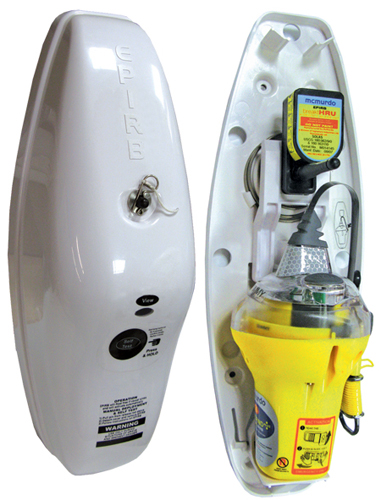Types of emergency locator beacons
by Admin
Posted on 25-09-2023 12:47 PM

An
emergency
position-indicating radiobeacon (epirb) is a type of emergency locator beacon for commercial and recreational boats, a portable, battery-powered radio transmitter used in emergencies to locate boaters in distress and in need of immediate rescue. In the event of an emergency, such as a ship sinking or medical emergency onboard, the transmitter is activated and begins transmitting a continuous 406 mhz distress radio signal, which is used by search-and-rescue teams to quickly locate the emergency and render aid.
![]() The signal is detected by satellites operated by an international consortium of rescue services, cospas-sarsat , which can detect emergency beacons anywhere on earth transmitting on the distress frequency of 406 mhz.
The signal is detected by satellites operated by an international consortium of rescue services, cospas-sarsat , which can detect emergency beacons anywhere on earth transmitting on the distress frequency of 406 mhz.
Epirb is one of three main types of radio beacons that are used in emergency situations for search and rescue. Epirbs (emergency position indicating radio beacons) for maritime use elts (emergency locator transmitters) for aviation use plbs (personal locator beacons) for personal use (in a remote environment) all of them - epirbs, elts and plbs - operate within a satellite-based system at a frequency of 406 megahertz. This frequency has been designated internationally for use only in distress. Also, emergency beacons should be equipped with a 121. 5 mhz radio transmitter. A low- power 121. 5 mhz homing signal is used to guide rescue services when they are within 10 miles away from the beacon.
Search-and-rescue response
All boatu. S. Foundation epirbs are the 406 mhz model and uses the cospas/sarsat system of polar orbiting satellites. The advantages of a 406 epirb are worldwide coverage, position location accuracy, a reliable transmitted signal, an encoded message that identifies the distressed vessel, and a faster response
time
. For long offshore trips, a 406 epirb is the way to go. A gps enabled 406 epirb's accuracy is roughly within 100 yards of the initial alert which is a vast improvement from the old 121. 5 mhz epirbs.
 Once registered and in the event of an activation, the unique encoded digital message is received by the satellites are then transmitted back to ground-based search and rescue authorities.
Once registered and in the event of an activation, the unique encoded digital message is received by the satellites are then transmitted back to ground-based search and rescue authorities.
Once switched on (activated), an epirb transmits a signal which will be picked up by satellites within the international cospas-sarsat search and rescue satellite system. Satellites receive signals sent on the 406 mhz frequency, the standard international frequency for distress beacons. The satellite retransmits the signal to the nearest ground receiving station (local user terminal) which then sends the signal to the closest mcc (mission control centre). The mcc analyses the signal and sends it to the responsible rcc. In new zealand’s search and rescue region, this is the rccnz based in lower hutt. When they receive a signal, the rccnz begins a search and rescue response.
An epirb is an emergency position indicating radio beacon that can help search and rescue authorities pinpoint your position in an emergency. Basically, it’s a portable electronic device that, once activated, emits a continuous and distinctive radio distress signal for at least 48 hours. Epirbs are often referred to as distress beacons or emergency beacons because that is their primary function. Epirbs are intended for usage, in order of suitability, for maritime, land and air expeditions. Epirbs are used by bush-walkers, campers, four-wheel drivers, modern-day explorers, as well as those onboard domestic and commercial marine vessels. An epirb with gps, in-built gps, is ideal as it will help first responders find you.
The bridge between the ground segment and the search and rescue segment is the rescue coordination centre (rcc). The rcc receives the alert from the mcc and is then responsible for coordinating the actual rescue response. In the us, the rcc for epirbs is the us coast guard. Different coast guard districts cover different geographical areas. If the emergency is outside of a particular coast guard district, they can liaise with local search and rescue providers. For example, if the us coast guard received an alert that a us epirb has been activated near the uk, they would liaise with falmouth coastguard for the rescue.
Emergency Locator Transmitters
The international cospas-sarsat system ceased satellite processing of 121. 5/243 mhz beacons on 1 february 2009. Although emergency locator transmitters used by aircraft may still be used, alerts from these devices or from 121. 5/243 mhz epirbs will no longer be acted upon unless independently confirmed by two independent non-satellite sources. These class a, class b, and class s devices are no longer allowed to be manufactured, imported, used or sold within the united states. Please see 47 cfr §80. 1053 prohibition on class a, class b, class s, and inmarsat-e epirbs.